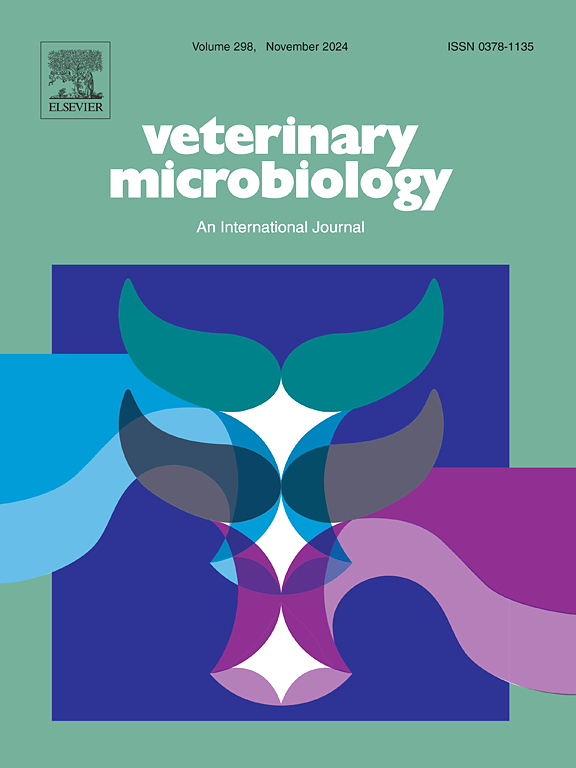自然条件下表面健康的亚洲水牛口蹄疫病毒RNA/抗原的亚临床感染及定位
IF 2.7
2区 农林科学
Q3 MICROBIOLOGY
引用次数: 0
摘要
本研究旨在确定亚洲水牛口蹄疫(FMD)病毒RNA和/或抗原的亚临床感染和组织特异性定位,因为它们可能参与引发新的疫情仍存在争议。从屠宰场采集亚洲水牛(n = 70)的血清、口咽液(OPF)和11种不同组织样本,分别进行3ab3 -非结构蛋白(NSP)抗体滴度测定、病毒分离和基因组检测、血红素和伊红(HE)检测和间接免疫荧光测定。其中,04份(血清)、14份(OPF)和18份(组织)样本分别检测NSP抗体和口蹄疫病毒基因组RNA/Ag阳性。然而,口蹄疫病毒(FMDV)无法从任何阳性OPF或组织样本中分离出来;这可能是因为测试系统的灵敏度有限/ FMDV浓度低。免疫荧光显微镜检测FMDV检出率最高的部位为背软腭(DSP)-2,其次为DSP1、鼻咽部背侧(DNP)-2、DNP1和腭扁桃体(PTON)。因此,在生活在自然环境中的无症状亚洲水牛中,DSP和DNP可能是口蹄疫病毒的主要定位位点。然而,由于在现场很难区分暂时性急性亚临床感染和持续性感染,特别是在屠宰场监测中,因此需要在受控条件下用已知的持续性感染水牛确认病毒RNA/抗原定位的位置。此外,没有证据表明3AB3 NSP抗体阳性率与组织样本和OPF的基因组鉴定有关。为了确定是否存在相关性,必须使用各种程序和测试对更多的样本进行评估。本文章由计算机程序翻译,如有差异,请以英文原文为准。
Subclinical infection and localization of foot-and-mouth disease viral RNA/antigens in apparently healthy Asiatic buffalo under natural condition
The present study aimed to identify the subclinical infection and tissue-specific localization of foot-and-mouth disease (FMD) virus RNA and/or antigen in Asiatic-buffaloes as their possible involvement in starting new outbreaks is still up for debate. Serum, oropharyngeal fluid (OPF), and 11 distinct tissue-samples were taken from the slaughterhouses from Asiatic-buffaloes (n = 70) and processed for 3AB3-non-structural protein (NSP) antibody titre estimation, virus isolation and genome detection, haematoxylin and eosin (HE) examinations, and indirect immunofluorescence assays, respectively. Of these, it was found that 04 (serum), 14 (OPF), and 18 (tissue) samples tested positive for NSP Ab, and FMD Viral genomic RNA/Ag, respectively. Nevertheless, FMD Virus (FMDV) could not be isolated from any of the positive OPF or tissue samples; this might be because of limited sensitivity of the test system/low concentration of FMDV. The dorsal-soft-palate (DSP)-2 was shown to have the highest rate of FMDV detection by immunofluorescence microscopy, followed by DSP1, dorsal nasopharynx (DNP)-2, DNP1, and palatine tonsil (PTON). Therefore, in asymptomatic Asiatic-buffaloes living in natural environments, DSP and DNP might be the primary FMDV localization sites. However, since it can be difficult to distinguish between temporally acute subclinical infections and persistent infections in the field, particularly in abattoir surveillance, the site of viral RNA/antigen localization needs to be confirmed with known persistently infected buffaloes under controlled conditions. Moreover, there was no evidence linking the 3AB3 NSP antibody positive rate to the genome identification in tissue samples and OPF. To determine whether a correlation occurs at all, more samples must be assessed using various procedures and tests.
求助全文
通过发布文献求助,成功后即可免费获取论文全文。
去求助
来源期刊

Veterinary microbiology
农林科学-兽医学
CiteScore
5.90
自引率
6.10%
发文量
221
审稿时长
52 days
期刊介绍:
Veterinary Microbiology is concerned with microbial (bacterial, fungal, viral) diseases of domesticated vertebrate animals (livestock, companion animals, fur-bearing animals, game, poultry, fish) that supply food, other useful products or companionship. In addition, Microbial diseases of wild animals living in captivity, or as members of the feral fauna will also be considered if the infections are of interest because of their interrelation with humans (zoonoses) and/or domestic animals. Studies of antimicrobial resistance are also included, provided that the results represent a substantial advance in knowledge. Authors are strongly encouraged to read - prior to submission - the Editorials (''Scope or cope'' and ''Scope or cope II'') published previously in the journal. The Editors reserve the right to suggest submission to another journal for those papers which they feel would be more appropriate for consideration by that journal.
Original research papers of high quality and novelty on aspects of control, host response, molecular biology, pathogenesis, prevention, and treatment of microbial diseases of animals are published. Papers dealing primarily with immunology, epidemiology, molecular biology and antiviral or microbial agents will only be considered if they demonstrate a clear impact on a disease. Papers focusing solely on diagnostic techniques (such as another PCR protocol or ELISA) will not be published - focus should be on a microorganism and not on a particular technique. Papers only reporting microbial sequences, transcriptomics data, or proteomics data will not be considered unless the results represent a substantial advance in knowledge.
Drug trial papers will be considered if they have general application or significance. Papers on the identification of microorganisms will also be considered, but detailed taxonomic studies do not fall within the scope of the journal. Case reports will not be published, unless they have general application or contain novel aspects. Papers of geographically limited interest, which repeat what had been established elsewhere will not be considered. The readership of the journal is global.
 求助内容:
求助内容: 应助结果提醒方式:
应助结果提醒方式:


